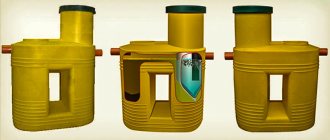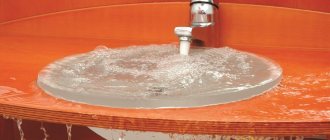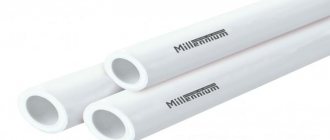Local sewerage with its own treatment plant will allow you not to break away from civilization in settlements that do not have basic infrastructure. If you make a septic tank with your own hands from barrels as a cleaning object, the cost of improvement will be minimal. But for a successful result, technological subtleties are needed. Isn't it true?
We offer everyone who wants to acquire an autonomous sewer system on their own site useful information that thoroughly covers all aspects of its construction. The practical application of the information we provide is a guarantee of long service life and flawless operation of the system.
This interesting article presented to your attention introduces various structural types of homemade septic tanks. It describes in detail the technology for constructing a sewage treatment plant from waste barrels. Construction methods are illustrated with simplified graphics, photos and video applications.
Features of arranging a cesspool from a barrel
A modern comfortable house requires an autonomous sewerage system. Thanks to it, residents can use all the amenities without going outside, which is especially important in winter or in bad weather. However, to install such a system, you need to create a cesspool or septic tank. This is a special underground reservoir into which all sewage flows - from the sink, shower, bathtub and toilet.
In most cases, private houses are equipped with large waste storage tanks - with a capacity of several cubic meters. However, if the number of one-time or daily waste discharges is small and the geological conditions of the area ensure rapid absorption of the liquid fraction (drainage), then to equip a drainage pit you can get by with a small container - a barrel for a couple of hundred liters.
If there is a large volume of wastewater, you need to install several barrels connected in series Source stroy-podskazka.ru
The construction of a country toilet with a sewage system based on a receiver from a 200 liter barrel meets the following practical conditions:
- A single-chamber device - one barrel acting as a primary and receiving settling tank fully satisfies the requirements of an economical septic tank.
- Disposal of the liquid part of the wastewater, most of it water, occurs due to absorption into the lower layers of the soil through perforations specially made for this purpose.
- A one-time discharge of wastewater should not exceed 90-95% of the tank’s capacity, and a daily discharge should not exceed 1 m3 (subject to rapid absorption by the soil).
- The tank for receiving sewerage is installed in accordance with special installation requirements, if possible at the lowest point of the site.
Important! Construction of a drainage pit from a barrel without a bottom is permissible in the case when the groundwater level is low enough. If soil currents even seasonally rise to a level of about 1 meter, without reaching the bottom of the reservoir, the runoff will penetrate into surrounding water sources and poison them. In this case, only a sealed tank can be installed.
Sewer well made from a barrel with a hatch Source ytimg.com
How to make an aeration field?
If the groundwater in the area is high, it is necessary to use a different septic tank design: instead of the last chamber - a filtration well - a filtration field is installed. It is done like this:
- A trench is dug in a suitable place, which at one end rests against the second tank of the treatment plant. The depth of the recess is 60 - 70 cm, and the width should be such that two drainage pipes with perforated walls can fit in it.
- The inner surface of the trench is covered with geotextile. The cut must be wide enough, since it will also need to cover the pipes laid in the trench.
- The trench is filled halfway with crushed stone, which must be leveled and compacted.
- It is necessary to lay perforated pipes on the crushed stone layer, connecting them at one end to the second barrel. Holes in the barrel should not be cut next to one another, but at a certain distance, so that the angle between their axes when viewed from above is 45 degrees.
- A 10-centimeter layer of crushed stone is poured over the pipes. Then the entire structure is “wrapped” in geotextiles, laying its edges with an overlap of 15–20 cm.
- The filtration field must be covered with soil. Now you can grow a lawn or flower bed here.
Instead of geotextiles, you can use banner fabric - a durable waterproof material coated on both sides with a thin layer of PVC.
In addition to plastic septic tanks, there are other options. Construction of a septic tank from concrete rings: advantages and disadvantages, step-by-step installation instructions.
You can find positive and negative reviews about the Tank septic tank in this block.
Varieties of suitable containers
If fluctuations in the capacity of household barrels - varying from 180 to 250 liters - do not greatly affect the performance of the septic tank, then the type of material from which they are made determines one of the most important parameters - service life. Therefore, it is extremely important to find out in advance which product is best suited for specific conditions of use, taking into account the impact of a number of destructive factors such as:
- Degree of soil moisture.
- Climatic features, including temperature changes.
- Amount of precipitation.
- Composition of the waste mass - will only natural household waste be poured into the tank, or also synthetic detergents, household chemicals, etc.
There are two main types of household barrels - plastic and metal. The former are distinguished by their inertness to corrosion processes, the latter have maximum strength. Therefore, it is preferable to make a septic tank for a toilet from an iron barrel in a place where large mechanical loads are expected - for example, if the pit is installed in a driveway or parking area for vehicles. The service life of such a container is on average 10-12 years.
Installing a septic tank from a plastic barrel Source na-dache.pro
See also: Catalog of companies that specialize in engineering systems (heating, water supply, sewerage and others) and related work
Available options
There are several options for containers available to a wide range of consumers for arranging a cesspool for sewer drains:
- A specially designed container equipped with an inspection hatch, a hole for installing ventilation and elements for draining. If necessary, it is possible to install several tanks connected in series - when the volume of wastewater is large enough. It is characterized by good packaging and installation without the need for modifications, but will cost the owner more than a regular barrel.
- Steel barrel. It will be cheaper than the above option, but will require modifications - the creation of perforations, holes for exhaust hood, anti-corrosion coating, etc. As a rule, despite its low cost and high strength, the wall material is quickly destroyed by corrosion processes.
A steel barrel can withstand frost even when installed shallowly in the ground, but quickly rusts Source stroy-podskazka.ru
- Plastic barrel. It is made on the basis of PVC or other polymers with similar properties. Does not corrode. Therefore, it will last an order of magnitude longer than its metal counterpart. However, such a container is not very durable and may collapse if heavy mechanical loads are applied in the installation area - for example, a car passing by.
Note! The depth of the cesspool for a barrel without a bottom should be 30-40 cm greater than its height. This is necessary to arrange a filtration layer of 20-30 cm of fine crushed stone and 10-20 cm of sand. Passing through it, the wastewater will be naturally purified before being absorbed into the ground.
Pros and cons of plastic and metal barrels
The metal barrel has a large margin of safety. This gives her an advantage when the cold season arrives. In addition, it will not collapse if it is installed close to the surface and a heavy vehicle passes over it.
An economical option for designing a septic tank from a barrel Source remontik.org
However, a steel tank used for sewer drains also has a number of significant disadvantages:
- Low corrosion resistance. Without the use of special protection, as well as under the influence of an aggressive environment, the walls of the container will rust through, already 3-5 years after installation.
- High price. It’s one thing when an old barrel, previously used in everyday life or decommissioned from production, is used, another thing when you have to specially purchase it in a completely new form. The price of the latter is quite high.
- Difficult to install. The large weight and dimensions often create difficulties in installing the container in a specially prepared hole, especially if it is significantly deepened to eliminate the influence of negative temperatures in winter.
- The optimal wall thickness should be from 15 mm. Such thick-walled specimens, as a rule, go beyond the scope of household consumption. You need to either look for them specifically or order them. In addition, such barrels have an impressive weight, and it will not be possible to install them without special equipment.
In a 2-chamber septic tank, the first barrel has a bottom and is equipped with ventilation, the second is located below and passes water into the ground through a filtration pad Source stroyfora.ru
Operating principle of the treatment plant
In septic tanks of this type, wastewater is treated primarily mechanically:
- Partial clarification during the deposition of the largest particles of impurities occurs mainly in the first of three series-connected containers.
- Smaller inclusions settle in the second tank, into which water flows from the top of the first barrel.
- The “native” bottom of the third barrel is usually removed, and when installing a septic tank, the lower part is backfilled with sand, gravel or expanded clay. This material acts as a filter.
Passing through the ground achieves optimal results, but this method is not suitable for areas with groundwater located close to the surface. To ensure sanitary safety in such cases, drainage of treated wastewater through filtration fields is organized. Such structures are perforated pipes insulated with geotextile, which come out of the third barrel at an angle of 45° to each other and are located in trenches parallel to the surface.
Requirements for the installation site
When choosing a place for arranging a flush barrel for a toilet in a country house, it is recommended to follow the following series of rules:
- The distance from the home is at least 10 meters. Waterlogged soil formed as a result of regular runoff can negatively affect the strength of the foundation of the structure. In addition, a sewer close to the house will lead to the formation of unpleasant odors inside the house.
- The distance to outbuildings is at least 7-8 meters. The presence of dampness can lead to the development of mold, rot, fungi and other microorganisms, the activity of which quickly destroys structures.
- The location of the drain point relative to the house is mainly on the leeward side, since even at a distance during windy conditions, unpleasant odors can penetrate into the home.
- The distance to the nearest natural source of water is at least 20-25 meters, and to the water supply system - 10 m.
- The distance to the site fence is at least 1 meter.
Where can a septic tank be installed?
Construction and sanitary standards stipulate the minimum distances between the septic tank and the following objects:
- water intake wells and wells: on soils with good drainage capacity (sand and sandy loam) - 50 m, on all others - 30 m;
- garages and bathhouses - 1 m;
- neighboring plot - 2 m;
- trees (distance to filtration fields) - 4 m;
- busy roads and parking lots: - 4 m.
If you plan to pump out accumulated sludge using a sewer truck, choose a place with access for it.
The septic tank should be installed at a distance of no more than 5 m relative to the house. If the structure is placed further, it will have to be buried deeply to ensure a slope for the pipe running from the house. In addition, if the pipe is long enough, it will often become clogged.
Rules for choosing a barrel
In order for sewage from the toilet, sink, shower and bath to be disposed of in its entirety, the drainage barrel for the drain must be selected in accordance with the following series of criteria:
- Total volume of waste. In this case, the maximum possible amount of drainage should be taken into account both at one time and during the day with the use of all plumbing fixtures installed and connected in the house.
- The nature of the operation of the sewer system - frequency, periodicity, seasonality.
- The type of soil at the site where the drain tank is dug in, its hydrogeological parameters, as well as the level of soil water.
- The financial amount that is planned to be spent on the project.
In most cases, a plastic or steel barrel is best suited for organizing drainage.
Video: designing water supply and sewerage systems in nanoCAD VK
Sewage systems for summer cottages
The scheme can be oriented in two directions - with connection to central sewer networks and with the organization of a local autonomous network. Therefore, before starting installation, it is necessary to develop a plan that should take into account the following parameters and indicators:
- The dimensions of the house are its height, width and length.
- Places for installing plumbing fixtures.
- Plumbing sizes.
- Methods for connecting devices to.
All this will affect the scheme, which you can do yourself without resorting to the services of specialists.
Installation stages
In order to properly make a toilet in a country house with a toilet and a modern sewer system, you need to properly prepare and dig a barrel according to the following instructions:
- Select a location for installing the drain tank in accordance with special requirements.
- Dig a hole corresponding to the dimensions of the barrel being installed, taking into account the filter pad.
- Fill the bottom of the pit with crushed stone and sand to form a filter.
- After compacting the materials, install a pre-prepared barrel without a bottom.
- Connect a drain pipe to the container that carries waste from the house's sewer system.
- Fill the side cavities between the barrel and the walls of the pit with soil.
- Install the cover.
- Test the system.
Advice! To get rid of the characteristic sewer odors near the tank and inside the house, it is necessary to install ventilation. To do this, a pipe up to 3 meters high, topped with a fungus to protect against precipitation, must be installed in the hole in the lid of the barrel or in the tee of the drain pipe.
Materials and tools
Before making a septic tank from a barrel, in order to avoid unplanned interruptions during the work process, it is better to prepare everything you need in advance.
Main components:
- metal or plastic barrels,
- sewer pipes (most often used with a diameter of 110 mm), the total length of which is 1-2 meters greater than the length of the main line,
- tees corresponding to the diameter of the pipes,
- sewer covers for barrels,
- pipes for ventilation (in some cases sewer pipes can be used),
- covers for ventilation (purchased or home-made protective canopies),
- corner fittings,
- flanges, couplings.
Installation materials:
- PVC glue (if plastic containers are used),
- sealant,
- cement,
- sand,
- crushed stone,
- fastening cables or clamps.
Tools:
- Bulgarian,
- shovel,
- electric mixer
Briefly about the main thing
If the volume of sewage from a private or country house does not exceed 1 cubic meter per day and is less than the capacity of the drain tank for a single discharge, then a 200 liter barrel can be used to install a toilet. In this case, a septic tank of this kind will be single-chamber, and most of the liquid fraction from the wastewater will be filtered and absorbed by the lower layers of the soil.
Barrels for the cesspool can be made of plastic and metal, specially designed for this purpose and equipped with appropriate devices, or ordinary household ones. The main advantages of plastic specimens are durability, inertness to corrosion and aggressive environments, the disadvantage is low mechanical strength and insufficient frost resistance. The advantage of metal barrels is their high strength; the disadvantages are associated with a short service life due to susceptibility to rust.
The location for the arrangement of the drain tank must meet the following requirements:
- At least 10 meters from the house.
- Minimum 7-8 m to utility structures.
- Location on the leeward side of the house.
- To the water source - from 20 m, to the water supply - at least 10 m.
- To the fence of the site - from 1 m.
When choosing a barrel, the volume of wastewater, the nature of operation, the type of soil and the budget of the event are taken into account. The installation of the sewerage system should be carried out according to the instructions in compliance with technical rules.
Ratings 0
What are the advantages of making your own design?
If there is no centralized water supply and sewerage network near the site, there is a need to build an autonomous system. A self-made septic tank from barrels disposes of wastewater in accordance with hygienic standards.
The design is designed to withstand a certain volume of sewage, taking into account the people living in the house. Installation of a homemade device is recommended for the following reasons:
- Reduced costs.
- Independent purchase of components + use of existing materials.
- Use of available tools.
- The equipment is installed according to a modular scheme, that is, the possibility of additional equipment is calculated in advance - connecting additional drain pipes to reserved entry points.
Only a person who has built his own drainage system understands the weaknesses of the design and knows its maximum capabilities. By calculating the approximate norms of water consumption of a family, the frequency of residence and, having studied the features of the land plot, you can avoid unnecessary financial costs, physical losses, and prevent “emergency situations” caused by low capacity.
After the process is completed, about 65% of the water is discharged into the ground, and sediment accumulates at the bottom until it is pumped out of the treatment plant.
Sanitary standards
Before you begin installing a septic tank at your summer cottage, you need to study sanitary standards, select the area, and the installation capacity. If something goes wrong, you can poison the soil with waste and harm people living in the surrounding area.
Power
The power of a septic tank is its dimensions. To calculate what size the structure should be, you need to perform several steps:
- On average, after three people, 100 liters of water drain.
- This number must be multiplied by 3. The resulting 300 liters are converted to m3. This volume is enough for 1 day.
- It must be taken into account that the water must stand for 14 days to be completely cleaned.
The optimal chamber volume for 3 people is 4 m3.
Location
The location must be chosen depending on the type of surrounding buildings and plants:
- fruit trees - 3 meters;
- fences - 3 meters;
- residential buildings - 5 meters;
- stream, pond - 10 meters;
- wells - 25 meters;
- reservoirs - 30 meters;
- wells - 50 meters;
- treatment facilities - 5 meters.
It is recommended to draw in advance a diagram of the location of the main objects on the site and think over the location of the septic tank.
Place for draining liquid
There are several options for where the waste fluid is drained:
- on uneven terrain;
- into the soil;
- into the pond.
The water must undergo long-term filtration to remove any debris or harmful substances.
Organization of septic tanks for cottages with high groundwater levels
The construction of a sewer system can be complicated by the presence of a high groundwater level on the site. These conditions impose restrictions on the treatment of wastewater passing through septic chambers, and the durability of the structure itself is significantly reduced.
The way out of this situation will be the construction of a sealed storage septic tank. Thanks to sealing, excess ground moisture will not be able to interact with wastewater and affect the process of its purification. Such structures have only one drawback. There is a need to regularly use the services of a sewer truck. And this already runs counter to the desire to create a cleaning structure that provides a long period of use without pumping.
Draining water from a septic tank into a ditch or storm drain
To achieve the desired result, you can use a standard scheme with a more complex structure. The design provides for the installation of a sealed container. The material for it can be concrete or plastic. This container must be divided into chambers designed to supply waste water and remove purified liquid.
The process of installing a septic tank with a high groundwater level
Choosing a septic tank for an area with high groundwater
If there is high groundwater in a suburban area, when choosing a treatment plant, you should be guided by some rules. They will help you choose the right type of septic tank and make a quality installation.
Basic Rules:
The volume of the treatment structure is calculated based on the speed at which wastewater will be processed over a specified period (day). Materials of polymer origin or concrete are the safest and most reliable basis for creating a septic tank. Horizontally located septic tanks with a small depth can offer the highest efficiency. Suitable options for treatment structures: storage or providing the possibility of forced pumping of purified liquid. Increasing the number of chambers increases the degree of cleaning.
Scheme for selecting a treatment plant depending on the groundwater level
Groundwater located close to the surface imposes restrictions on the use of certain materials.
In such conditions, you should abandon the construction of septic tanks:
- made of brickwork with gaps;
- from tires;
- from concrete rings.
Perforated pipes for drainage should also be excluded from the list of materials used.
The choice of septic tanks for installation is quite large. Most of them can be installed by hand. You can use improvised means, for example, bricks or tires (only for drains from a country shower) or purchase a ready-made structure from a specialized company.
https://youtube.com/watch?v=VgLADEPrtu4











